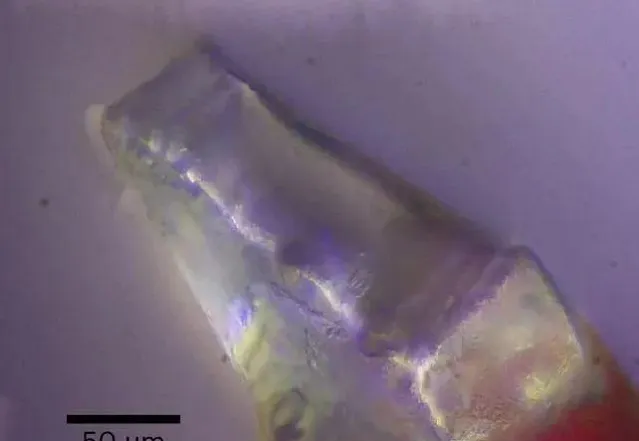
來源丨Sciencealert Space
作者丨 Michelle Starr
轉譯丨百度轉譯AI大模型
月球上有水,科學家們剛剛確認了大量水可能藏匿的地點。
There's water on the Moon, and scientists have just confirmed where a lot of it may be hiding.
中國嫦娥五號著陸器收集並運送至地球的月球塵埃中的一種礦物質最近被發現含有大量的水,占其重量的41%。
A mineral in Moon dust collected by China's Chang'e-5 lander and ferried to Earth was recently found to contain so much water, it makes up 41 percent of its weight.
這種礦物與幾年前在俄羅斯堪察加半島的玄武巖中發現的novograblenovite相似。月球和地球上的這兩種礦物都具有化學式(Np)MgCl3·6pO,並且具有相似的晶體結構。
The mineral is similar to novograblenovite, which was only identified a few years ago in basaltic rock from Russia's Kamchatka Peninsula. Both the lunar and terrestrial versions have the chemical formula (Np)MgCl3·6pO, and have similar crystalline structures.
鑒於我們可以在地球上研究新礦物,在月球上發現一種幾乎相同的礦物可以為我們提供一些線索,告訴我們月球水藏在哪裏,它是如何到達那裏的,以及月球水的歷史。
Given that we can study novograblenovite right here on Earth, the discovery of an almost identical mineral on the Moon can give us some clues about where lunar water is hiding and how it got there – as well as the history of lunar pO.
月球上水的來源、存在和分布仍然是個謎。這是科學家們想要弄清楚的問題,因為月球上的水分來自哪裏,現在又在哪裏,是地球-月球系統歷史的重要組成部份。
The origin, presence, and distribution of water on the Moon remain something of a mystery. It's something scientists want to figure out, because where the Moon's moisture came from and where it is now is an important component of the history of the Earth-Moon system.
此外,知道水藏在哪裏對未來的月球探索任務具有重要意義,因為人類生存需要水。
In addition, knowing where water is lurking has significance for future lunar exploration missions, since humans need water for survival.
之前在較老的月球樣本中也發現了水,這些水被困在微小的玻璃珠中,這些玻璃珠是在月球表面物質融化並形成所謂的球體時產生的。在月球表面反射的光譜中檢測到水訊號表明,月球上還有更多的水。
Water has been found in older lunar samples before, trapped in tiny glass beads that are produced when surface material melts and forms what are known as spherules. Detections of water signals in the spectrum of light reflected from the Moon's surface suggest there's plenty more up there, somewhere.
一個普遍的觀點是,水存在於構成月球風化層的礦物質中。然而,此前的研究表明,月球土壤中存在的氫和氧可能以其他羥基分子的形式存在——這些化合物的氫和氧的比例與水的比例不同。
One prevailing notion is that water is bound up in minerals that comprise the lunar regolith. Previous studies, however, have suggested that the hydrogen and oxygen bound up in Moon dirt could be in the form of other hydroxyl molecules – compounds made up of hydrogen and oxygen in proportions different from that of water.
然而,當嫦娥五號於2020年12月降落在月球上時,它取得了一項突破——首次在月球上的一塊巨石中就地探測到疑似水。然而,目前尚不清楚探測到的究竟是分子水還是另一種羥基分子。這需要比機器人著陸器所能提供的更仔細的分析。
When it landed on the Moon in December 2020, though, Chang'e-5 made a breakthrough – the first in situ detection of what appeared to be water in a boulder on the Moon. It was unclear, though, whether the detection was actually molecular water, or another hydroxyl molecule. That required a closer analysis than what a robotic lander could provide.
現在,中國科學院物理學家金世峰和郝木楠帶領的地球人類已經進行了這項分析,他們將嫦娥五號任務送回地球的樣本進行了X射線晶體繞射和化學同位素分析技術,以確定月球風化層是否含有水或其他物質。
Now, humans on Earth led by physicists Shifeng Jin and Munan Hao of the Chinese Academy of Sciences have performed that analysis, subjecting samples sent to Earth by the Chang'e-5 mission to X-ray crystal diffraction and chemical isotope analysis techniques to determine whether the lunar regolith contains water or something else.

發現含有水的微小礦物顆粒
他們的努力揭示了分子水的存在,其中礦物(Np)MgCl3·6pO含有多達六個水分子晶體。
Their efforts revealed the presence of molecular water, with the mineral (Np)MgCl3·6pO containing up to six water crystals.
Novograblenovite在地球上很少形成,它是由熱玄武巖與富含水和氨的火山氣體相互作用而產生的。月球礦物不太相同——其中發現的氯同位素與陸地氯同位素的組成不同——但其形成機制可能非常相似。
Novograblenovite rarely forms on Earth, emerging from the interaction of hot basalt with volcanic gasses that are rich in water and ammonia. The lunar mineral isn't quite the same – the chlorine isotope found within it has a different composition to terrestrial chlorine isotopes – but its formation mechanism is likely to be quite similar.
這表明,當月球過去火山活動活躍時,月球上存在水和氨的來源。
This suggests a lunar source of both water and ammonia existed when volcanic activity was active in the Moon's past.
中國科學院在一份聲明中寫道:「熱力學分析表明,當時月球火山氣體中水含量的下限與地球上最幹燥的火山——倫蓋伊火山的下限相當。」
"Thermodynamic analysis shows that the lower limit of the water content in the lunar volcanic gas at that time was comparable to that of the driest volcano on Earth today, Lengai Volcano," the Chinese Academy of Sciences writes in a statement.
「這揭示了月球火山脫氣的復雜歷史,對探索月球的演化具有重要意義。」
"This reveals a complex history of lunar volcanic degassing, which is of great significance for exploring the evolution of the Moon."
這一發現還表明月球上存在一種以前未知的水源——水合鹽。這比水冰穩定得多,表明它甚至可能在經常沐浴在陽光下的月球區域存在,從而減少我們未來對月球兩極陰影隕石坑深處封存的水冰的依賴。
The discovery also suggests a previously unknown source of water on the Moon – hydrated salts. This is much more stable than water ice, suggesting that it may be available even on areas of the Moon frequently bathed in sunlight, reducing our future possible reliance on water ice sequestered deep in shadowed craters at the lunar poles.
該團隊的發現已在【自然天文學】上發表。
The team's findings have been published in Nature Astronomy.
內容來源於百度人才智庫【今日資訊差】欄目精選推薦
百度轉譯,200種語言互譯,4萬多個轉譯方向,內含新聞資訊等9大行業領域轉譯。AI大模型轉譯還支持知識庫上傳及專業術語客製,轉譯後可進行譯文編輯、雙語審校、聯網查證、譯文答疑、母語潤色、語法分析,滿足各行業專業人士的全方位需求。
歡迎存取PC端 🔍 https://fanyi.baidu.com 體驗更多產品功能











